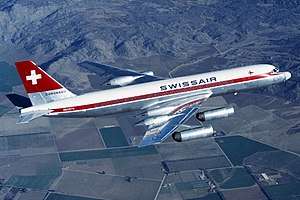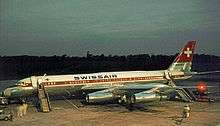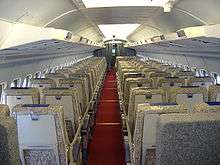Convair 990 Coronado
The Convair 990 Coronado is an American narrow-body four-engined jet airliner produced by the Convair division of General Dynamics, a stretched version of their earlier Convair 880 produced in response to a request from American Airlines. The 990 was lengthened by 10 ft (3.0 m), which increased the number of passengers from between 88 and 110 in the 880 to between 96 and 121 in the 990. This was still fewer passengers than the contemporary Boeing 707 (110 to 189) or Douglas DC-8 (105 to 173), although the 990 was 25–35 mph (40–56 km/h) faster than either in cruise.
| Convair 990 Coronado | |
|---|---|
 | |
| The Convair 990 is a low-wing airliner with four underwing turbofans. | |
| Role | Narrow-body jet airliner |
| National origin | United States |
| Manufacturer | Convair |
| First flight | January 24, 1961 |
| Introduction | 1962 |
| Retired | September, 1987 (1994 with NASA) |
| Primary users | American Airlines Spantax Swissair |
| Produced | 1961-1963 |
| Number built | 37 |
| Developed from | Convair 880 |
Design and development
American Airlines asked Convair to design an aircraft for coast-to-coast flights, able to fly nonstop from New York City to Los Angeles against the wind. They wanted a somewhat larger passenger capacity than the 880, which was the smallest of the first-generation U.S. jet airliners. The 990 began flight testing January 24, 1961.[1]
One change from the 880 was the large anti-shock bodies on the upper trailing edge of the wings to increase the critical Mach and reduce transonic drag. The inboard shock bodies, which were larger, were also used for additional fuel tankage. Later during the design period, Convair modified the design to include fuel in the outboard pods as well, but during the initial test flights the extra weight caused the outboard engines to oscillate in certain conditions. The pods were redesigned once more, and shortened by 28 inches (710 mm), causing increased drag. The inner set of pods also served a secondary role as fuel dumps for the fuel tanks, and the outlet pipe is prominent.[2]
The engines were also changed to the uprated General Electric CJ-805-23s, which were unique in that they used a fan stage at the rear of the engines, compared to the fan stage at the front of the engine found on the Pratt & Whitney JT3D that powered the 990's competitors. The engine was a simplified, non afterburning civil version of the J79, used in military fighters. Like most versions of the J79, the CJ805 and CJ805-23 were smoky, although secondary operator Spantax eventually had their 990 aircraft refitted with smokeless combustion chambers in the 1970s.
Like the 880, 990s incorporated a dorsal "raceway" added to the top of the fuselage to house the two ADF antennas and one VHF antenna[3]
Operational history
The 990 did not meet the specifications promised, and American Airlines reduced their order as a result. The 990A was developed by adding fairings to the engine nacelles, among other changes.[4] Despite the modifications from the basic 880 and those in response to drag problems in testing, the aircraft never lived up to its promise of coast-to-coast nonstop capability from JFK to LAX. American Airlines' timetables show little or no difference in scheduled time between 707 and 990A flights; AA began to dispose of their 990As in 1967.
The Convair 990A is still the fastest non-supersonic commercial transport to have ever been produced. During May 1961, one of the pre-production 990 prototype aircraft set a record of .97 Mach in level flight at an altitude of 22,500 ft. (6.9 km), equivalent to a true airspeed of 675 mph (1 086 km/h).[5] This was before the various aerodynamic drag-reduction changes were applied to the later 990A in order to meet certain performance guarantees which Convair had made to American Airlines. These subsequent modifications made to the later 990A (consisting of the four wing-mounted anti-shock body "speed capsules" and substantial streamlining of the engine pylon/wing interface) increased the velocity at which onset of transonic drag would occur by 0.09 Mach. As such, the 990A would have been capable of speeds slightly in excess of 700 mph (1 130 km/h).[6]
In 1963, the 990A was reported to burn 13,750 pounds (6.24 t) per hour of fuel at Mach 0.84 (483 knots, 895 km/h) at 35,000 ft (10.7 km) at a mass of 200,000 lb (90.7 t).[7] In contrast, a modern Boeing 737 MAX 8 typically carries 162 passengers and burns 4,460 lb (2.02 t) per hour at Mach 0.78 (450 kn; 833 km/h) at sub-optimal parameters.[8]

Swissair bought eight 990As beginning in 1962, operating them on long-distance routes to South America, West Africa, the Middle and Far East, as well as on European routes with heavy traffic. Their fleet was withdrawn from service in 1975. Scandinavian Airlines also operated Coronados on their long-haul schedules to Tokyo and other destinations in the Far East.
The 990's niche was soon captured by the Boeing 720 and Boeing 720B, derivatives of the Boeing 707, and later by the Boeing 727. By the time the assembly line shut down in 1963, only 37 990s had been produced, bringing General Dynamics' entire production of commercial jet airliners to 102 airframes. The failure of airlines to broadly accept the Convair 880 and 990 led Convair's parent company, General Dynamics, to suffer what at the time was one of the largest corporate losses in history. As a result, Convair exited the jet airliner business, although they later profitably built fuselages for the McDonnell Douglas DC-10, KC-10 and MD-11.
When the major airlines retired their Convair 990s, they found a second life on charter airlines. Spantax of Spain had a large fleet until the mid-1980s and so did Denver Ports of Call. In 1967, Alaska Airlines purchased Convair 990 PP-VJE from Varig, and operated it as N987AS in scheduled airline service until 1975.
Variants
- 990 : Initial production version.
- 990A : Higher cruising speed and longer range.[9]
Operators

- Aerolíneas Argentinas
- Aerolíneas Peruanas S.A.* - Aerolineas Peruanas operated two Convair 990As from Callao International Airport, Lima.[10]
- Air France (one aircraft leased in 1967)
- Alaska Airlines
- American Airlines*
- AREA (Ecuador)
- Cathay Pacific
- Ciskei International Airways
- Denver Ports of Call
- Iran Air
- Garuda Indonesian Airways*
- Internord Aviation
- LANICA (Nicaragua)
- Lebanese International Airways
- Middle East Airlines
- Modern Air Transport
- NASA
- Nomads Travel Club
- Nordair
- Northeast
- SAS*
- Spantax
- Swissair* (Only Swissair called their 990 aircraft, "Coronado")
- Thai Airways International
- Varig* / Real-Aerovias
*Original operators.
Accidents and incidents
- May 28, 1968: A Garuda Indonesian Airways Convair 990 (PK-GJA) crashed in a nearly vertical attitude, minutes after takeoff from Bombay-Santacruz Airport outside Bombay, India, killing all 29 passengers and crew on board and one person on the ground.[11] The aircraft was departing for Karachi, Pakistan.
- January 5, 1970: A Spantax Convair 990 (EC-BNM) crashed at Stockholm-Arlanda Airport outside Stockholm, Sweden while taking off on a three-engine ferry flight to Zürich, Switzerland, killing five of seven passengers; the three crew members survived.[12]
- February 21, 1970: Swissair Flight 330 crashed near Würenlingen, Switzerland while trying to return to Zurich International Airport after a bomb detonated in the aft cargo compartment, killing all nine crew and 38 passengers. The aircraft was also carrying a significant amount of mail, some of which survived the crash.
- August 8, 1970: A Modern Air Transport Convair 990 (N5603) was being ferried from New York to Acapulco when it crashed on approach to Alvarez International Airport, Mexico. No one was killed but one of the eight crew was badly injured.[13]
- December 3, 1972: Spantax Flight 275 a Convair 990 (EC-BZR), crashed at Los Rodeos Airport on Tenerife while taking off in almost zero visibility, killing all seven crew and 148 passengers.[14]
- March 5, 1973: The 1973 Nantes mid-air collision occurred when Spantax Flight 400, a Convair 990, on a flight from Madrid to London was involved in a midair collision with Iberia Flight 504, a McDonnell Douglas DC-9, over Nantes. The Convair 990 lost part of its left wing, but its pilots managed to land safely at Cognac – Châteaubernard Air Base. The DC-9 crashed, killing all 68 passengers and crew on board.
- April 12, 1973: A U.S. Navy Lockheed P-3C (157332) operating from NAS Moffett Field in Sunnyvale, California collided with a NASA Convair 990 (N711NA) during approach to runway 32R. The aircraft crashed on the Sunnyvale Municipal Golf Course, half a mile short of the runway, resulting in the destruction of both aircraft and the deaths of all aboard except for one Navy crewman.[15][N 1]
- July 17, 1985: A NASA Convair 990 (N712NA) suffered a blown tire during take-off at a speed of around 140 knots (259 km/h) at Riverside-March AFB, California. While attempting to clear the runway, the rim shattered and caused a puncture of the right-wing fuel tank forward of the right main gear. All 19 occupants survived but the subsequent intense fire destroyed the plane, its equipment, and documentation.[16]
Surviving aircraft
- 30-10-2 – In storage with Scroggins Aviation at the Mojave Air and Space Port in Mojave, California. This aircraft was formerly operated by Aérolíneas Peruanas.[17]
- 30-10-5 – Cockpit in storage at a scrapyard in Tucson, Arizona.[18]
- 30-10-12 – On display at the Swiss Museum of Transport in Lucerne, Switzerland. This aircraft was formerly operated by Swissair.[19]
- 30-10-18 – Forward fuselage preserved at Sabadell Airport in Sabadell, Spain for cabin crew training. This aircraft was formerly operated by Spantax.[20]
- 30-10-29 – On display as a gate guardian at Mojave Air and Space Port in Mojave, California. This aircraft was formerly operated by American Airlines, Modern Air Transport, and NASA.[21]
- 30-10-30 – In storage at Palma de Mallorca Airport in Palma, Majorca since 1987. This aircraft was formerly operated by Spantax.[22]
Specifications (Convair 990A)
Data from Jane's All the World's Aircraft 1965-66[23]
General characteristics
- Crew: 4 (+ cabin crew)
- Capacity: up to 149 passengers
- Length: 139 ft 9 in (42.60 m)
- Wingspan: 120 ft (37 m)
- Height: 39 ft 6 in (12.04 m)
- Wing area: 2,250 sq ft (209 m2)
- Aspect ratio: 6.2
- Empty weight: 133,000 lb (60,328 kg)
- Maximum zero-fuel weight: 160,000 lb (72,575 kg)
- Max takeoff weight: 253,000 lb (114,759 kg)
- Maximum landing weight: 202,000 lb (91,626 kg)
- Powerplant: 4 × General Electric CJ805-23B turbofan engines, 16,050 lbf (71.4 kN) thrust each aft=fan engines
Performance
- Maximum speed: 540 kn (620 mph, 1,000 km/h) at 20,000 ft (6,096 m) at 200,000 lb (90,718 kg) AUW
- Maximum speed: Mach 0.871
- Maximum permissible diving speed: M0.91
- Cruise speed: 484 kn (557 mph, 896 km/h) / M0.84 at 35,000 ft (10,668 m)
- Stall speed: 109 kn (125 mph, 202 km/h) at 170,000 lb (77,111 kg) AUW with wheels and flaps down
- Range: 3,302 nmi (3,800 mi, 6,115 km) with 104,373 lb (47,343 kg) usable fuel, 25,770 lb (11,689 kg) payload and 18,000 lb (8,165 kg) reserve fuel
- Service ceiling: 41,000 ft (12,000 m)
- Wing loading: 112.44 lb/sq ft (549.0 kg/m2)
- Take-off run: 9,800 ft (2,987 m) at MTOW (SR-422B Field length)
- Landing run: 5,400 ft (1,646 m) at 170,000 lb (77,111 kg) AUW (SR-422B Field length)
See also
Related development
Aircraft of comparable role, configuration and era
Related lists
References
Notes
- One Navy crewman in the P-3 survived the crash. He was in the P-3's tail section, which broke off the aircraft as the 990 collided from above. He fell out of the broken tail section and survived with massive injuries. People at the golf course who witnessed the crash, tried to break open windows on the wreckage with golf clubs in a futile attempt to pull the injured out before fire consumed the crews.
Citations
- Proctor, Jon (June 1996). Convair 880 & 990 (First ed.). Miami: World Transport Press. p. 55. ISBN 0-9626730-4-8.
- Proctor, Jon (June 1996). Convair 880 & 990. Miami: World Transport Press. p. 55. ISBN 0-9626730-4-8.
- Convair Jet Airliners. San Diego: General Dynamics: Customer Service Dept. December 1961. p. 203.
- "Reduction of Drag Rise on the Convair 990 Airplane". AIAA Journal of Aircraft, Vol. 1 No. 1, January–February 1964, pp. 8–12.
- Lebanon (Pennsylvania) Daily News, May 18, 1961 p32
- "General Dynamics Loses Jet Pod Patent Suit", New York Times, February 20, 1970 p52
- Flight 31 Jan 1963 p150
- Fred George (May 12, 2017). "Pilot Report: Flying the 737-8, Boeing's New Narrowbody Breadwinner". Aviation Week & Space Technology.
- "The Might-Have-Beens: Convair 880 and 990." Airliners.net. Retrieved: August 20, 2011.
- "World Airline Survey Flight International, April 14, 1966, p. 595. Retrieved: December 23, 2011.
- Accident description for PK-GJA at the Aviation Safety Network. Retrieved on 2014-10-17.
- Accident description for EC-BNM at the Aviation Safety Network. Retrieved on 2014-10-17.
- Accident description for N5603 at the Aviation Safety Network. Retrieved on 2014-10-17.
- Gero 1997, p. 111.
- "Accident description: 12 APR 1973." Aviation Safety Network. Retrieved: August 20, 2011.
- Ranter, Harro. "ASN Aircraft accident Convair CV-990-30A-5 Coronado N712NA Riverside-March AFB, CA (RIV)". aviation-safety.net.
- "Convair 990, serial no. 02, N990AB". ConvairJet.com. ConvairJet.com. Retrieved 26 September 2016.
- "Convair 990, serial no. 05, N990AC". ConvairJet.com. ConvairJet.com. Retrieved 26 September 2016.
- "Convair CV-990 Coronado". verkehrshaus.ch. Retrieved 2015-11-11.
- "Airframe Dossier - Convair CV-990, c/n 18, c/r EC-BZP". Aerial Visuals. AerialVisuals.ca. Retrieved 26 September 2016.
- "Airframe Dossier - Convair CV-990-30A-5, c/n 29, c/r N810NA". Aerial Visuals. AerialVisuals.ca. Retrieved 26 September 2016.
- Edlind, Tony. "Spantax S.A (BX)". AngelFire. Tony Edlind. Retrieved 26 September 2016.
- Taylor, John W.R., ed. (1965). Jane's All the World's Aircraft 1965-66. London: Sampson Low, Marston & Company, Ltd. pp. 233–234.
Bibliography
- Gero, David. Aviation Disasters. Yeovil, Somerset, UK: Patrick Stephens Ltd (Haynes Publishing), 1997. ISBN 1-85260-526-X.
- Green, William. Macdonald Aircraft Handbook. London. Macdonald & Co. (Publishers) Ltd., 1964.
- Proctor, Jon. Convair 880 & 990. Miami, Florida: World Transport Press, 1996. ISBN 0-9626730-4-8.
- Taylor, John W. R. Jane's All The World's Aircraft 1965-66. London: Samson Low, Marston, 1965.
- Wegg, John. General Dynamic Aircraft and their Predecessors. London: Putnam, 1990. ISBN 0-85177-833-X.
External links
| Wikimedia Commons has media related to Convair 990 Coronado. |
